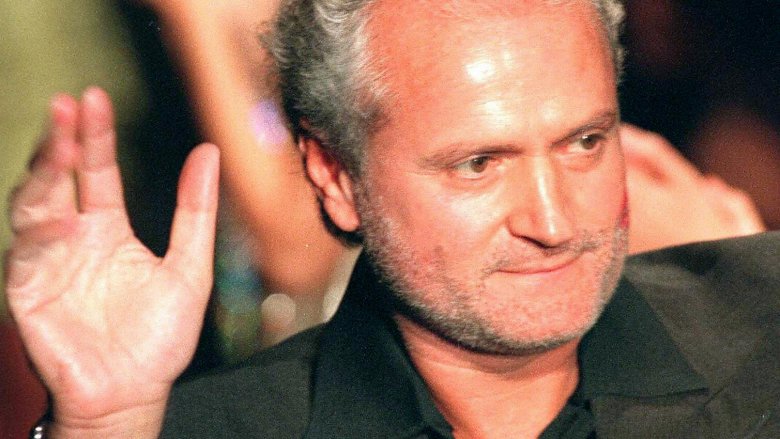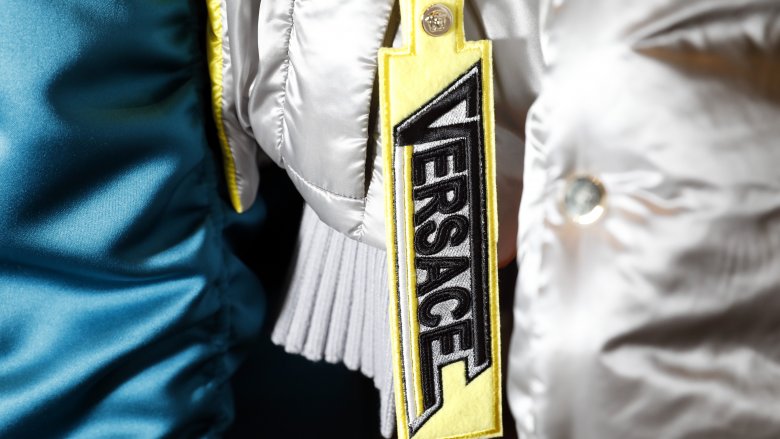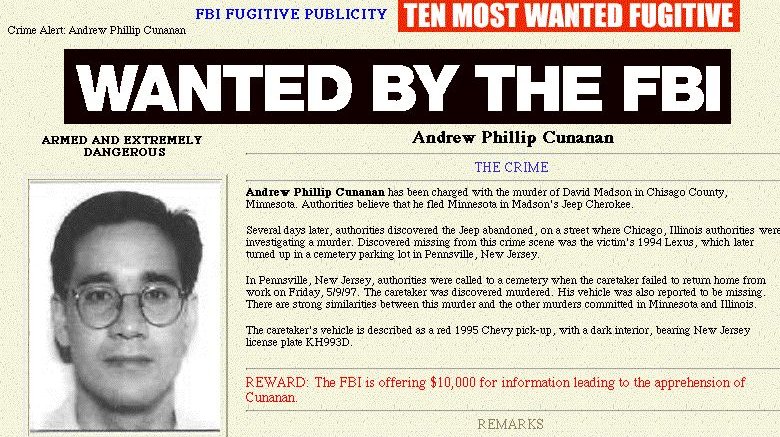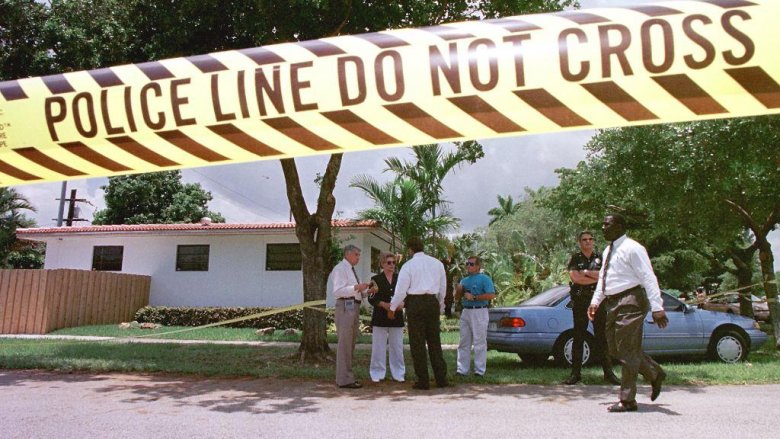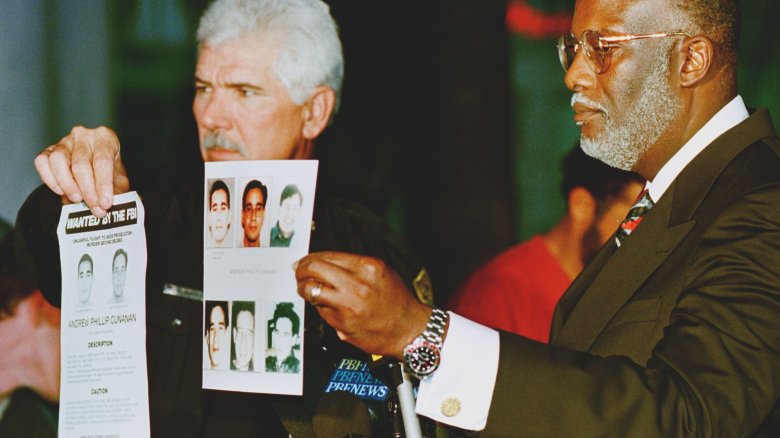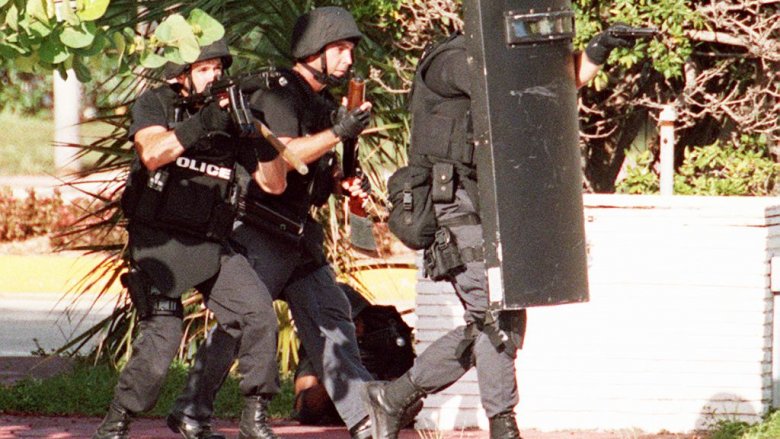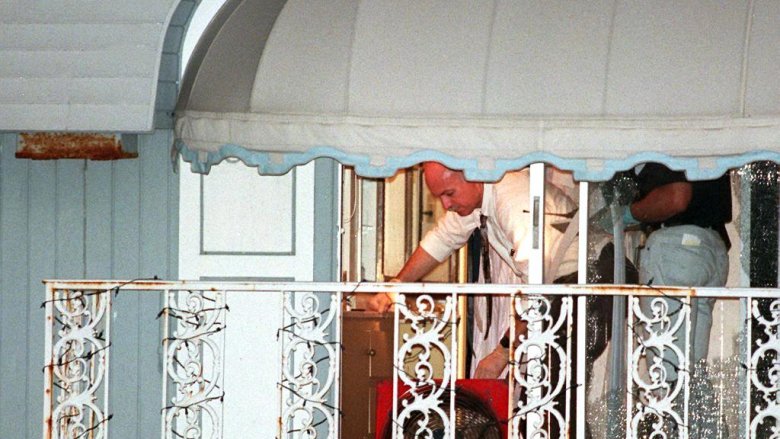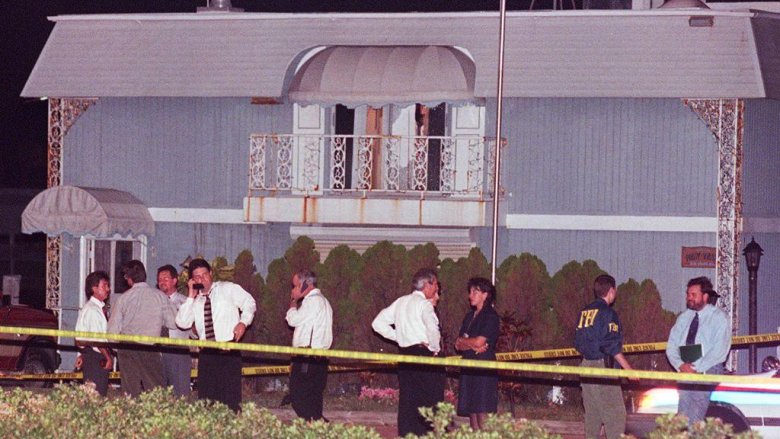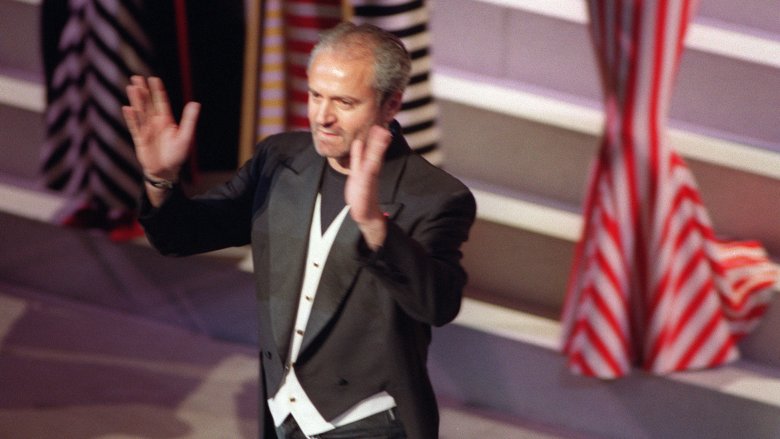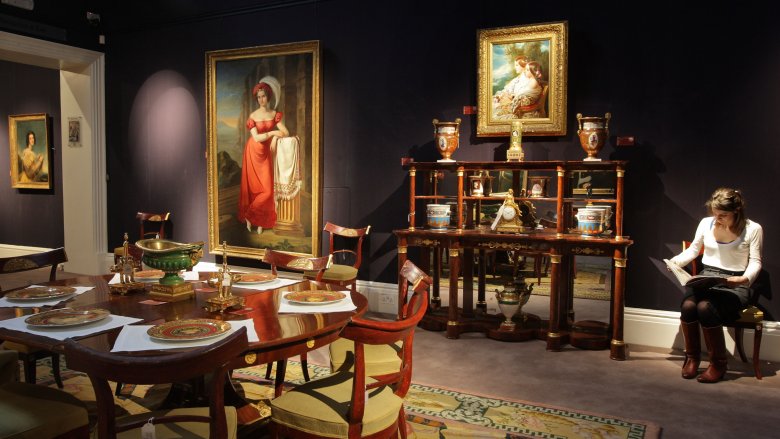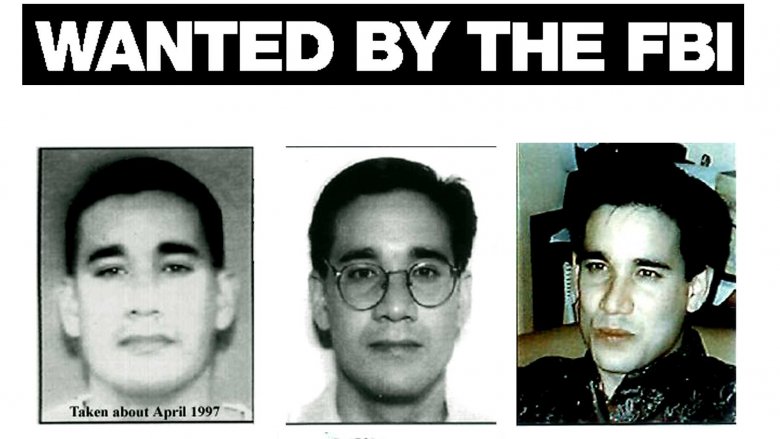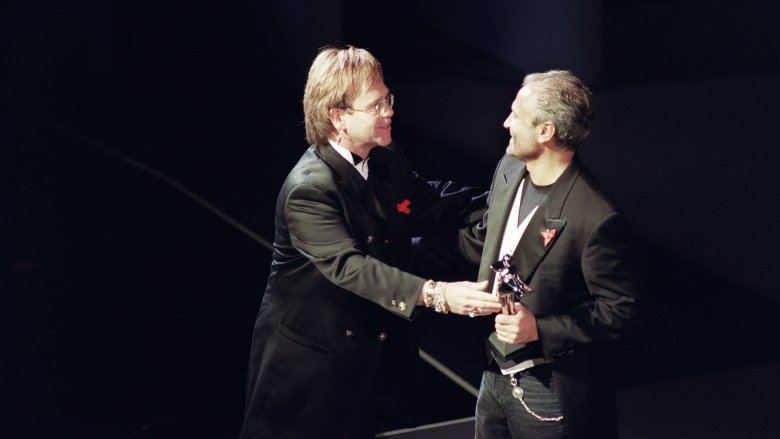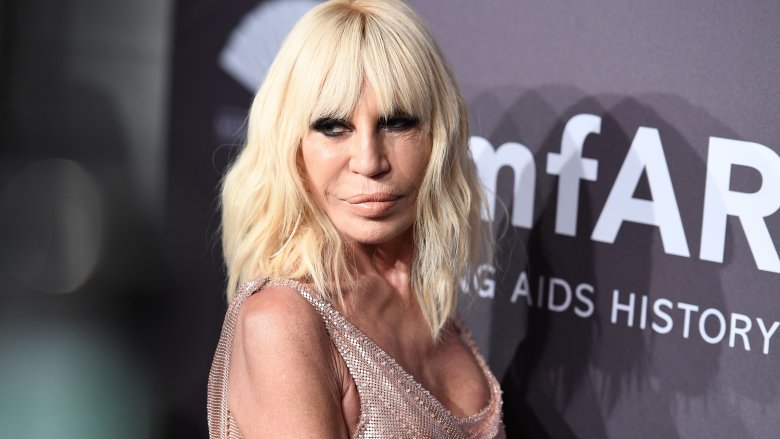Gianni Versace: The Untold Truth Of His Murder
As far as the fashion world was concerned, Gianni Versace was a rock star. Even those who didn't follow fashion knew his name, which is why, on July 15, 1997, his assassination on the steps of his South Beach mansion made headlines across the world.
The murder was insanely bold, taking place in broad daylight as Versace returned from his morning walk to a nearby cafe for his daily coffee. He was opening the gates to his home when a man approached him, shot him twice, and ran. The location became a site of pilgrimage for mourners, who covered the steps with flowers as soon as the police concluded their investigation at the scene. Witnesses who had seen the entire thing were interviewed and detained, Miami was put on alert, and a strange case unfolded. Decades later, there are still unanswered questions.
Antonio D'Amico speaks out after 20 years
At the time of the murder, Versace's longtime partner Antonio D'Amico was in their South Beach home. He appeared at the front of the house immediately after hearing the gunfire, and was fast enough that he saw Versace's killer. When police arrived, he accompanied them on a search for the assassin.
The murder of a loved one is something that haunts friends and family forever, and in April 2017 D'Amico still found himself reliving the horror. "I heard the shot," he told Keith Morrison, the NBC reporter of The Death of Gianni Versace: A Dateline Investigation. "My heart just stopped to beat. Something said to me... 'Something happened'. Anyway, so I ran out and then I saw Gianni laying down on the stairs in blood."
D'Amico has remained fairly silent on the circumstances surrounding the murder — and the investigation — until now; according to News.com.au, he also cut off all friendly contact with the Versace family. D'Amico and Donatella Versace have had a rocky relationship at the best of times, and since the tie that bound them was gone, his silence has extended to her, too.
Versace had met his killer before
Every morning, usually between 8:30 and 9AM, Versace would head down the street to the News Cafe to have a cup of coffee and pick up a handful of magazines. After drinking his coffee there, he would head back home. The Miami Herald quoted a hostess at the cafe as saying that whoever had killed him must have known the routine, and when Vanity Fair traced killer Andrew Cunanan's movements backwards from his ultimate end on a South Beach houseboat, they found that the two had met at least once before.
When reporter Maureen Orth spoke to Cunanan's friends, they said that he had mentioned Versace by name more than once. They had met at least once that they could confirm, on October 21, 1990, while at a club in San Francisco called Colossus. One of the people Orth spoke to had been there, and said that Versace even seemed to recognize him from a previous encounter at the designer's Lake Como home. Cunanan, they said, oozed pleasure at being recognized, but whether or not they truly had met before that night couldn't be substantiated. Rumor had it that Versace had been spotted in a car with Cunanan in San Francisco, too, but that was never substantiated with an eyewitness, either.
Who was Andrew Cunanan?
Versace's killer was ultimately identified as Andrew Cunanan, a 27-year-old who had a spot on the FBI's Ten Most Wanted List. Even though the manhunt ended on July 23 — only days after Versace's murder — justice was stubbornly elusive. Police discovered Cunanan's body on a houseboat only three miles from the world-famous murder site. Cunanan's own death was ruled a suicide, and there was no note.
Vanity Fair took a look at the strange life of the killer, describing him as a charming liar who was fascinated by the dark and sadistic. Tracing his footsteps took reporter Maureen Orth between Washington DC, Minneapolis, San Francisco, and San Diego before reaching Miami, and into an underground part of the gay community. He was found to have an obsession with S&M, and that he had already left a trail of bodies behind him before his murder spree ended with the execution of Versace. Those who knew him told stories of a high-class gay escort who worked in both Florida and California, a showman who professed his role in the drug trade and who targeted older, wealthy men... and made many of those around him uncomfortable.
Most eerie of all were the words of Frank Scottolini, manager of a South Beach nightclub called Twist. Scottolini remembered Cunanan as being in the club the weekend before the murder, and when he left, he also remembered remarking to the bartender, "There goes the gay serial killer." His words were prophetic, and they later identified Cunanan from surveillance video.
Cunanan's other victims
By the time Cunanan's murder spree came to an end with Versace's death, law enforcement had already established a list of other deaths that were attributed to him. According to The Washington Post, that started with Jeffrey Trial, an ex-Navy man and district manager for a Minnesota propane company who had left San Diego for Bloomington in fall of 1996. In April of 1997, Cunanan had caught up with him and bludgeoned him to death with a claw hammer. That murder happened in the apartment of Cunanan's second victim, and according to Crimefeed, it was the shooting death of an architect named David Mason that kicked off the murder spree in earnest.
After killing Trail and Mason, Cunanan headed for Chicago. His third victim, a 72-year-old real estate tycoon credited with helping to shape the Chicago skyline, was found by his wife. According to her, Cunanan had no connection with Lee Miglin or their family, leaving it a mystery as to why he had killed the businessman with gardening shears and a screwdriver. Cunanan stole Miglin's Lexus, abandoning it a week later near the body of his fourth victim, a cemetery caretaker named William Reese. Reese — who was known for helping visitors to the cemetery find their ancestors' names among the Civil War memorials — had been shot once in the head. It was Reese's pickup truck that Cunanan stole then used as a pit stop to change his clothes in after shooting his final victim, Gianni Versace.
Cunanan's plans to flee the country
According to CNN, Versace's assassination may have been the culmination of the killing spree. On July 25 — just days after Cunanan's suicide — the FBI released information that suggested he had been trying to flee the country. Cunanan had reached out to an unnamed acquaintance to see if he could get his hands on a passport, and suspiciously, that acquaintance hadn't reached out to law enforcement even amid the media frenzy that was stirred up by the search for answers.
Information is frustratingly scant, but according to FBI Deputy Director William Esposito, not only had Cunanan's passport been found in the car he had stolen from William Reese, but that he and his acquaintance had discussed 10 individuals as possible sources for a new passport. Those sources had been warned that their names had come up in a discussion with the killer, and also according to the FBI, the information only came to light when known associates of Cunanan were being questioned.
Whatever Cunanan's post-murder plans might have been, no one is entirely sure. According to the Los Angeles Times, whatever he had been planning might have been foiled by a completely unrelated car accident that had happened in front of the parking garage where he had left Reese's stolen truck, which may have forced him to remain in the area.
What the official autopsy revealed
Since Cunanan had shot Versace in broad daylight in front of witnesses, there wasn't much mystery around the circumstances surrounding his death. But when police released the official documents pertaining to the murder later the same year, CNN found there were more than 700 pages of findings, including the autopsy report.
The Sun-Sentinel reported on one particular detail of the autopsy that was particularly chilling. Although it had originally been claimed that Cunanan had come up behind Versace and shot him twice while he was opening the gate to his home, autopsy findings from the Dade Medical Examiner's Office suggested that Versace had actually turned and looked at Cunanan before being shot in the face. The wounds to his face — originally thought to be exit wounds — were entrance wounds, and only one of the two bullets that was fired was recovered.
Retired FBI agent Peter Smerick noted that this wasn't uncommon, and that Cunanan had damaged the faces of his previous victims as well. Smerick also said it was a signature of a rage killing.
A lawsuit needed to be filed to keep photos from becoming public
Not all of the information regarding the Versace murder was released to the public, and when CNN reported that hundreds of papers had been released by the FBI under the state's Public Records Act, there were no photos included in the release.
Versace's family had filed a lawsuit in order to keep the photos from being released to the public, and that lawsuit was the only way to keep them from being readily accessible under the same laws that made the FBI's files on the case public. CNN quoted the family's spokesperson, Lou Colasuonno, as saying, "We're just asking for respect for a guy who was a murder victim. Gianni Versace was the victim of a maniacal serial killer. And we should treat him like a victim — with respect."
Cunanan's odd ties to a German fugitive
Cunanan ended his own life on a houseboat before being brought to justice, and when law enforcement investigated the houseboat, they found some bizarre things. First, CNN reported that Cunanan had been living on the houseboat — which was sitting along Miami Beach about two miles from the Versace mansion — for at least a few days before he was discovered. Police found him by literally going door-to-door in the area, and discovered his body after a caretaker reported hearing a gunshot coming from the boat.
Originally, it was believed that the boat's owner was Torsten Reineck, and Reineck was identified as a German fugitive with a rap sheet that included fraud charges. Whether Cunanan — whose body was identified by thumbprints — had known the houseboat's owner or if he had stumbled across the empty boat was unknown (via CNN), but the whole thing took another strange twist. The Las Vegas Sun reported that Reineck wasn't the houseboat's owner at all, and that it had been sold to a contractor named Ruehl. Ruehl only learned of the incident on television, and said that he had nothing to do with either Reineck or Cunanan. Stranger still was the fact that not only was Reineck the owner of a spa that catered to a gay clientele, but he had opened his business under the name Torsten Ruehl. As for the houseboat itself, it sank in December 1997, and CNN reported that no foul play was suspected.
There were claims of connections to the mafia
In 2010, The Telegraph reported on a new book that hit the shelves and included some pretty shocking accusations. The book, Metastasi, was written by Guiseppe Di Bella, a one-time member of a branch of the mafia called N'drangheta. According to him, Versace's murder was orchestrated by the mob as payback for outstanding debts that he hadn't settled. Claims were made that Versace's business was used by the N'drangheta to launder money, and that here was another part to the plan. The mob had originally intended to steal Versace's ashes and then ransom them back to the family, but that part never happened.
The Versace family issued a statement, saying that not only were the claims 100 percent not true, but that they were "shameful".
Whether the claims were true or not, it wasn't the first time that Versace's name had been mentioned in the same breath as the mafia that ran the businesses of southern Italy from the shadows. In 1994, The Independent ran a piece on not only Versace's extravagance, but on how numbers associated with the business rarely added up. They reported that there were whispers about his connections to the mob, and also noted that he was born in Reggio Calabria, the hometown of the N'drangheta.
The Versace family's bizarre tangle with a private investigator
Frank Monte is a private investigator who's made some astonishing claims, including supposedly recovering the skull of heir Michael Rockefeller from the remote tribes of Papua New Guinea. In 1997, he also claimed to have inside information on what had really happened to Gianni Versace, but tracking down just what it was is a little tricky. According to a profile in The Independent in 2001, a gag order made it illegal for them to even repeat the claims. They do say, though, that Monte says that Cunanan wasn't simply the serial killer that he was painted as. The entire thing was supposed to be detailed — along with his other adventures — in his autobiography, but the Versace family filed a lawsuit to keep The Spying Game off the shelves.
Vogue reported a little more on the suit, which saw the Versace family heading to Australia to stop the book from being published. They revealed that there were claims that not only had he been hired by Gianni Versace to protect him in the years before his murder, but also that there was indeed mafia involvement. There were also accusations that the Versace siblings has something to do with the murder as well, and it's no wonder they filed suit against Monte and the book, which was ultimately pulled from publication. According to Monte's blog, the book was rewritten and released in 2003, with a footnote that his claims have been substantiated by the 2010 release of Metastasi.
The FBI documents that define the murder as retribution
Motive for the killings has always been something of a mystery but in 2014, ABC's I-Team uncovered FBI files that claimed the murder was for a simple reason: Cunanan wanted retribution. According to the files, Cunanan's unraveling came after a San Diego counselor gave him information on the spread of AIDS. He vowed to track down anyone who might have given it to him, and the documents quoted Cunanan as telling friends, "If I had AIDS or if someone did that to me I would go on a five-state killing spree and take everyone with me I could."
Cunanan was linked to both of his first two victims, according to Crimefeed, but investigators were always stumped by the murders of Miglin and Reese. Miglin's family had steadfastly insisted that they had no connection to Cunanan, but the FBI files seemed to suggest that there was evidence that Miglin had previously partaken of Cunanan's services as an escort. When ABC contacted Miglin's family, his widow refused to discuss the matter, but his son confirmed that the information in the FBI report was unsubstantiated.
The unanswered questions
On December 31, 1997, the Los Angeles Times reported that the investigation into Versace's murder — and Cunanan's other killings — had closed. The official verdict was that he had acted alone, but exactly why he had killed five people remained unclear. Miami Beach Police Chief Richard Barreto said, "What we cannot establish is motive. It might have been a robbery. It could have been Andrew Cunanan seeking the exposure of gunning down a person of this stature. It could have been revenge. We would all like to know, especially in a high-profile case like this. Unfortunately, the real answer to that went down with the ship, so to speak."
Also unknown are what connections Cunanan had to the owner of the houseboat he ultimately committed suicide in. Police were unable to discover anything concrete, but believed there was some sort of connection. No confirmation of a connection between Versace and Cunanan was ever made beyond claims made by friends, either, and concrete evidence Cunanan knew Reese, Miglin, or Versace never materialized.
The 2012 tribute to his life and death
In 2012, Donatella Versace paid tribute to her brother with the designs of her Autumn/Winter collection. According to The New York Times's review of the show, she unveiled it with the intention of gathering the courage needed to go back to her brother's work and pay homage to his inspiration.
Most noticeable was the motif of the Byzantine cross, metal mesh, and a lot of leather. With help from a German rock group called Das Glow, Donatella said that she had created the collection and the show around a phrase that her brother had used: Rock and Regal.
"I can look at it now with a smile," she said of her loss. "I remember my last moments with Gianni, the rehearsal, the show. But finally I have freedom. I am not afraid."

